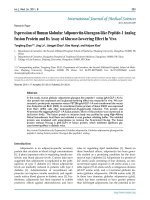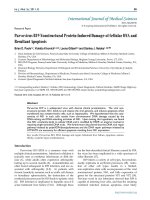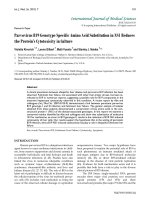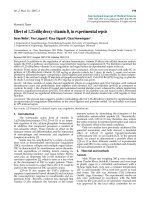Báo cáo y học: "Parvovirus B19 Genotype Specific Amino Acid Substitution in NS1 Reduces the Protein’s Cytotoxicity in Culture"
Bạn đang xem bản rút gọn của tài liệu. Xem và tải ngay bản đầy đủ của tài liệu tại đây (755 KB, 10 trang )
Int. J. Med. Sci. 2010, 7
110
I
I
n
n
t
t
e
e
r
r
n
n
a
a
t
t
i
i
o
o
n
n
a
a
l
l
J
J
o
o
u
u
r
r
n
n
a
a
l
l
o
o
f
f
M
M
e
e
d
d
i
i
c
c
a
a
l
l
S
S
c
c
i
i
e
e
n
n
c
c
e
e
s
s
2010; 7(3):110-119
© Ivyspring International Publisher. All rights reserved
Research Paper
Parvovirus B19 Genotype Specific Amino Acid Substitution in NS1 Reduces
the Protein’s Cytotoxicity in Culture
Violetta Kivovich
1,2
, Leona Gilbert
2
, Matti Vuento
2
and Stanley J. Naides
3
1. Pennsylvania State College of Medicine/ Milton S. Hershey Medical Center, Hershey, PA, U.S.A.;
2. Department of Biological and Environmental Science and Nanoscience Center, University of Jyväskylä, Jyväskylä, Fin-
land;
3. Quest Diagnostics Nichols Institute, San Juan Capistrano, CA, U.S.A.
Corresponding author: Stanley J. Naides, M.D., Mail: 33608 Ortega Highway, San Juan Capistrano, CA 92675. Phone: 949
728-4578; FAX: 949 728-7852; E-mail:
Received: 2010.01.26; Accepted: 2010.05.24; Published: 2010.05.25
Abstract
A clinical association between idiopathic liver disease and parvovirus B19 infection has been
observed. Fulminant liver failure, not associated with other liver-tropic viruses, has been at-
tributed to B19 in numerous reports, suggesting a possible role for B19 components in the
extensive hepatocyte cytotoxicity observed in this condition. A recent report by Abe and
colleagues (Int J Med Sci. 2007;4:105-9) demonstrated a link between persistent parvovirus
B19 genotype I and III infection and fulminant liver failure. The genetic analysis of isolates
obtained from these patients demonstrated a conservation of key amino acids in the non-
structural protein 1 (NS1) of the disease-associated genotypes. In this report we examine a
conserved residue identified by Abe and colleagues and show that substitution of isoleucine
181 for methionine, as occurs in B19 genotype II, results in the reduction of B19 NS1-induced
cytotoxicity of liver cells. Our results support the hypothesis that in the setting of persistent
B19 infection, direct B19 NS1-induced cytotoxicity may play a role in idiopathic fulminant liver
failure.
Key words: Parvovirus, B19, Fulminant Liver Failure, Cytotoxicity, Apoptosis
INTRODUCTION
Human parvovirus B19 is a ubiquitous infectious
agent known to cause erythema infectiosum in child-
ren, bone marrow suppression and chronic anemia in
susceptible individuals, and fetal hydrops and death
in intrauterine infections (2, 25). Studies have also
linked the virus to numerous idiopathic conditions
such as systemic lupus erythematosus (SLE)-like
syndromes, rheumatoid-like arthritis, and liver and
kidney disease (10, 27, 37, 40). The role of B19 in the
latter set of pathologies is difficult to discern because
the cellular tropism of the virus for erythroid precur-
sor cells (33) excludes viral replication as being the
cause of the observed cellular damage in replication
nonpermissive tissues. Two major hypotheses have
been proposed to explain the potential role of B19 in
such phenomena: an immune mediated attack of
end-organ antigens due to B19-induced molecular
mimicry (22, 43), or direct B19-mediated cellular
damage in the absence of viral particle replication
(43). Evidence for both mechanisms exists and it is
possible that both have a role to play in the diverse
clinical picture of B19 disease.
The B19 linear, single-stranded DNA genome
encodes three major viral proteins; two structural
capsid proteins (VP1 and VP2) and three
non-structural proteins (the major 77 kDa NS1 and the
Int. J. Med. Sci. 2010, 7
111
minor 11 kDa and 7.5 kDa proteins, the latter two
whose functions remain unclear) (39, 48). The hu-
moral response to B19 infection is initially directed
against the major viral capsid protein VP2. As the
recovery process progresses, however, this response
becomes replaced by antibodies against the unique
region of VP1 (24). It has been suggested that im-
mune-mediated tissue injury in B19 infection may be
the result of cross-reactivity between IgG antibodies
against VP epitopes and human antigens (22, 23). On
the other hand, the non-structural protein of B19
(NS1) is a candidate mediator of direct cell injury.
B19 virus targets erythroid cells via the major
host cell receptor glycolipid globoside, also known as
the blood group P antigen (4), as well as two core-
ceptors, α5β1 and Ku80. The presence of P antigen,
however, is not sufficient for B19 replication (43).
Studies have suggested that intracellular conditions,
such as viral DNA transcription and RNA processing,
are involved in establishing cell permissiveness (5, 14,
21). However, tissues identified as non-permissive for
B19 replication have been shown to harbor genomic
evidence of B19 infection for extended periods of time
(7, 40). Although such non-permissive cells display an
inability to produce viral structural proteins and rep-
licate the viral genome, curiously these same tissues
allow transcription and translation of NS1 (18, 34, 47).
The non-structural NS proteins of parvoviruses
are central to the viral life cycle, mediating viral ge-
nome transcription, replication, and packaging. These
multi-domain proteins have a conserved architecture:
the N-terminus encodes for the DNA binding and
endonuclease domains (30, 45); the central region
contains the conserved NTP-binding and helicase
motifs that identify the protein as a member of the
AAA+ SF3 helicase group (9, 13, 25); and the unique
C-terminus region has been suggested to be involved
in host-protein interactions and promoter
trans-activation activity (10, 19, 31). The three major
genotypes of B19 have been shown to have most of
their nucleotide diversity localized to the C-terminus
region of its non-structural protein (16, 37). However,
until recently no specific amino acid variation has
been associated with a single clinical presentation of
B19 disease (16, 20). In 2007, Abe and colleagues (1)
performed a sequence analysis of B19 NS1 isolated
from the livers of two patient groups; group A con-
tained patients with idiopathic fulminant hepatitis
while group B was made up of patients with biliary
atresia. The study correlated the presence of geno-
types 1 and 3 in patients with idiopathic fulminant
hepatitis, while only genotype 2 was identified in pa-
tients with biliary atresia. Furthermore, conserved
(I181M, E201D) amino acid substitutions were identi-
fied in patients with biliary atresia that were not ob-
served in the fulminant hepatitis group. Since biliary
atresia is a congential condition yet to be linked with
an infectious cause (36), identification of conserved
amino acid substitutions in the B19 NS1 isolates of
only the group A patients suggests that these residues
may be critical to the mechanism of B19-associated
fulminant liver failure.
B19 has long been linked with a spectrum of liver
disease ranging from self-limited hepatitis to acute
fulminant liver failure (18, 28, 46). The significant as-
sociation of bone marrow suppression with acute
fulminant liver failure in the pediatric population (6,
15) along with the isolation of B19 DNA from liver
tissue (12), which has been shown to be
non-permissive for viral replication (3), but allows
transcription and translation of B19 NS1 (18, 34), has
lead us to examine the potential role of B19 NS1 in
direct hepatocyte cytotoxicity. Our laboratory pre-
viously demonstrated that B19 NS1 caused apoptosis
in liver-derived cells (34, 35). The above described
study by Abe et al. (1) led us to explore the effect of
the NS1 I181M amino acid substitution on B19
NS1-induced cytotoxicity in liver cells. Our work has
shown that the I181M substitution significantly re-
duces B19 NS1-induced apoptosis in HepG2 cells,
suggesting an important role for this residue in the
mechanism of B19 NS1-induced liver cytotoxicity.
MATERIALS AND METHODS
Cell Culture. Spodoptera frugiperda-derived SF9
cells were cultured in spinner flasks using BioWhit-
taker® Insect-XPress cell media (BioWhittaker® ,
Walkersville, MD) supplemented with 1% Penicil-
lin-Streptomycin (PenStrep) (Gibco®, Invitrogen,
Carlsbad, CA) at 27°C. HepG2 cells were cultured in
Hepatocyte Wash Media (Gibco®) supplemented
with 10% Fetal Bovine Serum (FBS) (Gibco®), 1%
L-glutamine (Gibco®) and 1% PenStrep. The cells
were incubated at 37°C in 5% CO2.
Cloning and Recombinant Baculovirus Pro-
duction. A modified pFastBac1 (Invitrogen, Carlsbad,
CA) vector was used as a backbone for the generation
of B19 NS1 expressing baculovirus. The polyhedrin
promoter was removed from the pFastBac1 plasmid
by SnaB1 (Fermentas, Glen Burnie, MD) and BamH1
(Fermentas) digestion. The Cytomegalovirus (CMV)
immediate-early promoter was obtained from
pcDNA3.1 (Invitrogen) by NruI (Fermentas) and
BamH1 digestion and used to replace the
SnaB1-BamH1 fragment in pFastBac1, resulting in
pCMVFastBac1. The vector was again digested with
Nhe1 (Fermentas) and BamH1 in order to insert a
fragment encoding the Enhanced GFP (EGFP) protein
Int. J. Med. Sci. 2010, 7
112
obtained from pEGFP-C1 (Clontech Laboratories Inc.,
Saint-Germain-en-Laye, France) using the same re-
striction enzymes, resulting in pCMVEGFPwoFast-
Bac1. The native B19 NS1 sequence was obtained from
the PBDP2 vector (34). Mutagenesis of the native se-
quence was performed using the sequential PCR
technique (8). Briefly, two overlapping fragments of
the desired mutant construct were produced using
unique internal oligonucleotides encoding a collection
of point mutations and deletions and B19 NS1 generic
external primers (Table 1). The two fragments were
then annealed by mutually primed synthesis using
the EcoR1 (Fermentas) and Xba1 (Fermentas) encod-
ing B19 NS1 generic external primers (Table 1). The
following mutants were generated: PathT, a single
amino acid replacement, T183A, and PathI, a single
amino acid replacement, I181M. The NS1 constructs
were ligated into the EcoR1-Xba1 digested
pCMVEGFPwoFastBac1 vector backbone to produce
the desired EGFP-NS1 fusion protein and its muta-
tions under the CMV immediate-early promoter.
Recombinant baculoviruses were prepared using
the Bac-to-Bac® Baculovirus Expression system (In-
vitrogen). Third generation virus was collected by
centrifugation at 1500 x g for 10 min. Sterile inacti-
vated fetal bovine serum (FBS) (Gibco®) was added to
each virus to make a 10% solution after which the
stock was filtered through a 0.2 µm filter (Millipore,
Billerica, MA) and stored at 4°C.
Table 1. Primers Used for B19 NS1 and Substitution
Construct Cloning.
Construct Primer
External
Primers
F- 5’ GGCGACGAATTCATGGAGCTATTTAG GG
R- 5’
GGCCATCTAGATTACTCATAATCTACAAAGCT
PathT -
PRMTTA
1- 5’ AGTATCATTTATGGCTACGGTAATG
2- 5’ ATTACCGTAGCCATAAATGATACTAGTAG
Baculovirus Transduction of HepG2 Cells.
HepG2 cells were seeded in culture flasks and grown
overnight in supplemented media as described above.
The following day the media was removed, cells
washed once with sterile phosphate buffered saline
(PBS), and the baculovirus solution added to the cul-
ture flask. A multiplicity of infection (moi) equivalent
to ~100-200 was used for each experiment, resulting in
a transduction efficiency of ~25% for each virus at 24
hrs post-transduction. The treated HepG2 cells were
kept on ice and remained immersed in the baculovi-
rus solution for 1 hr to promote viral binding to the
cellular membrane, after which the virus suspension
was removed, the cells washed once with sterile PBS
and then pre-warmed supplemented media added.
Transduced HepG2 cells were stored at 37°C in 5%
CO2. Transduction efficiency was established using
flow cytometry as described below.
Flow Cytometry. HepG2 cells were collected by
trypsinization (0.5% Trypsin EDTA (Gibco®) in PBS
(Gibco®) at indicated times, washed once with fresh
media (500 µL) and counted to prepare required cell
numbers per sample for each experiment. For trans-
duction efficiency analysis, 5 x 10
5
HepG2 cells were
resuspended in 500 µL of ice-cold PBS and imme-
diately analyzed by flow cytometry. For AnnexinV
binding analysis 5 x 10
5
cells were washed once with
PBS and resuspended in 500 µL AnnexinV Binding
Buffer and 5 µL AnnexinV-PE (AMS Biotechnology
LTD., Abington, OX, UK), incubated for 15 min at
room temperature in the dark and immediately ana-
lyzed by flow cytometry. The percentage of cells ex-
pressing the EGFP marker, as well as the distribution
of signal intensity for each construct transduced, were
established, in order to ensure that a comparable
amount of protein was being expressed in each con-
struct transduction, for the comparison of different
NS1 mutant groups.
For examination of apoptosis using the SubG1
population in cell cycle analysis, 3 x 10
6
cells were
washed once with ice cold PBS and fixed in 70%
ice-cold ethanol (900 μl) for 24-48 hrs at 4°C. The fixed
cells were washed twice with PBS to rehydrate the
sample and incubated in propidium iodide 40 μg/ml
(Molecular Probes (Invitrogen), Carlsbad, CA) and
RNase 40 μg/ml (Roche Basel, Switzerland) in PBS at
37°C for 20 min. The cells were centrifuged, resus-
pended in ice-cold PBS and immediately analyzed by
flow cytometry.
All samples were analyzed on the
FACSCALIBUR flow cytometer (Becton-Dickson,
Frankline Lakes, NJ), data collected using Cell-Quest
software (Becton-Dickson), and statistical analysis
completed by FlowJo software (Tree Star, Inc, Ash-
land, OR).
Cytotoxicity Assay. Trypan blue dye exclusion
was used to determine cell viability. Adherent and
loose HepG2 cells were collected by trypsinization
(0.5% Trypsin EDTA (Gibco®) in PBS (Gibco®) at
indicated times and washed once in sterile PBS. The
cells were then resuspended 1:10 in trypan blue solu-
tion (0.8 mM trypan blue in PBS) and incubated at
room temperature 2-5 min. The cells were counted
using a hemocytometer and trypan blue stained cells
were identified. The results were quantified as num-
ber of trypan blue staining cells out of total cells
counted.
Int. J. Med. Sci. 2010, 7
113
Statistical Analysis. Student t-test was used to
assess the statistical significance in the data.
RESULTS
Substitution I181M in B19 NS1 interferes with
NS1-induced apoptotic cell death. To test the hypo-
thesis that B19-associated liver pathology is related to
the direct toxicity of persistent B19 NS1 in hepatocytes
of previously infected individuals, we examined the
possible role of specific amino acid variation in the
B19 NS1 protein on liver toxicity. The clinical obser-
vation by Abe et al. (1) of B19 genotype variability in
different liver disease groups, identified two amino
acid substitutions in B19 NS1 that differed between
the biliary atresia and fulminant liver failure patient
groups. Substitution E201D, believed to be in the B
cell epitope of B19 NS1 (40), substituted one acidic
residue for another, suggesting a conserved mutation
that would not significantly change the chemical
properties of the protein. An immunological analysis
of B-cell activation would need to be completed in
order to understand the potential impact of this subs-
titution on B19 NS1. Therefore, we focused our anal-
ysis on the second substitution, I181M, observed only
in genotype 2-carrying biliary atresia patients. We
created EGFP tagged constructs of wild type genotype
1, I181M (PathI) substitution and T183A (PathT)
substitution of B19 NS1 under the CMV immediate
early promoter. The PathT substitution was observed
in genotype 3 of B19 but not in genotype 1, both of
which could be found in patients with fulminant liver
failure, and was used as a second negative control,
along with the wild-type B19 NS1 construct. These
constructs were cloned into the baculovirus expres-
sion system, which was used as a gene delivery ve-
hicle.
24 hrs post-transduction of HepG2 cells with
baculovirus carrying the above described B19 NS1
constructs, trypan blue dye uptake analysis showed
an increased amount of cell death in cells expressing
B19 NS1-derived proteins compared to mock infected
(Cell) or EGFP expressing cells (Figure 1). Although
slightly less death could be seen in the PathI trans-
duced cells at 24 hr post-transduction, the difference
between the constructs was not statistically signifi-
cant. HepG2 cell cytotoxicity continued to increase as
the cells continued to express B19 NS1. At 48 hrs
post-transduction 36% (Figure 1) of HepG2 cells ex-
pressing wild-type NS1 showed loss of viability.
HepG2 cells transduced with constructs expressing
PathI and PathT exhibited a similar pattern of cell
loss, with continued decline in cell viability until 48
hrs post-transduction. However, unlike wild-type B19
NS1- and PathT-transduced cells, approximately 10%
fewer PathI mutant transduced HepG2 cells showed
trypan blue uptake at 48 hrs post-transduction (p =
0.0002) (Figure 1).
Previous studies have identified apoptosis as the
underlying mechanism for the cytotoxicity observed
in the setting of transient B19 NS1 expression (34). We
therefore examined whether the reduced cell loss ob-
served in the PathI substitution- carrying HepG2 cells
resulted from a reduction in cells undergoing apop-
tosis. We used the AnnexinV binding assay to assess
apoptotic cell death in HepG2 cells. The pattern of
apoptosis observed in HepG2 cells expressing all B19
NS1 constructs showed continually increasing per-
centage of cells undergoing apoptosis starting at 24
hrs (Figure 2). At 48 hrs post-transduction the PathI
construct expressing cells displayed approximately
18% less apoptotic cell death than the wild-type and
PathT B19 NS1-expressing cells (p = 0.023) (Figure 2).
The reduced apoptotic cell death in the Pa-
thI-expressing cells resembled the reduction observed
with the generalized cytotoxicity assay, suggesting
that the reduced cell loss is due to a decrease in B19
NS1-induced cell suicide, previously reported to be
the mechanism of B19 NS1-induced cytotoxicity (34,
35).
Further confirmation for the reduction of apop-
tosis in the PathI transduced population of HepG2
cells was obtained using cell cycle analysis of HepG2
cells expressing the wild-type and mutant B19 con-
structs. Non-transduced HepG2 cells, HepG2 cells
transduced with moi 400 of non-engineered baculo-
virus, and HepG2 cells transduced with EGFP ex-
pressing virus to 95% transduction efficiency at 24 hrs
post-transduction were used to establish HepG2 cell
cycle distribution (negative controls). G0/G1, S,
G2/M and SubG1 (representing cells undergoing
apoptotic cell death) phases were identified on the
linear fluorescence intensity plots for propidium
iodide emission (Figure 3A). All three negative con-
trol conditions displayed the same pattern of cell cycle
progression with approximate distribution of cells at
48 hrs as follows; 71% G1, 16% S, 12% G2 and 1%
SubG1 (data not shown). For clarity only one repre-
sentative negative control condition, labeled Cell, is
presented in Figure 3.
HepG2 cells transduced with baculovirus car-
rying the NS1 constructs were identified by flow cy-
tometry and subsequent cell cycle analysis performed.
The pattern of cell cycle distribution for NS1 ex-
pressing cells differed significantly from that seen for
the negative controls (Figure 3A bottom panels). At 48
hrs post-transduction 20% of HepG2 cells expressing
the NS1 construct were in the SubG1 population
(Figure 3B). The SubG1 accumulation demonstrated
Int. J. Med. Sci. 2010, 7
114
the cytotoxic nature of B19 NS1, which has been pre-
viously shown to cause apoptotic cell death in HepG2
cells.
The cell cycle observations for NS1 expressing
cells were then compared to cells expressing the PathT
and PathI mutation constructs. At 24 hrs
post-transduction all mutant NS1 proteins exhibited a
similar effect on HepG2 cells as the wild-type NS1
protein with approximately 3% of cells in the SubG1
population (Figure 3B). At 48 hrs post-transduction,
however, a mean of 24.5 % of HepG2 cells expressing
the PathT construct were found in the SubG1 popula-
tion (Figure 3B). In contrast to this, only 11.5% of PathI
expressing HepG2 cells were identified in the SubG1
population (Figure 3B), suggesting a significant re-
duction in apoptotic cell death (p = 0.0317) compared
to the PathT construct expressing HepG2 cells. No
statistical significance was identified between the
wild-type NS1 and PathT construct expressing cells,
which we believe is due to the large variability in the
SubG1 content data for the wild-type NS1 transduc-
tion.
Figure 1. Cytotoxicity Assay. HepG2 cells were mock, EGFP-, NS1-, PathT-, or PathI- transduced, collected at indicated
times post-transduction and analyzed by trypan blue exclusion. The data represent the mean of three independent expe-
riments demonstrating the percentage of total cells in the sample permeable to trypan blue uptake. One star (*) – statistically
significant (p < 0.05) change between Cell and marked set. Two stars (**) – statistically significant (p< 0.05) change between
NS1 and marked set. Bars demonstrate the standard deviation between individual runs.









